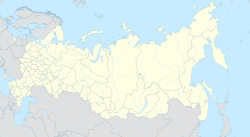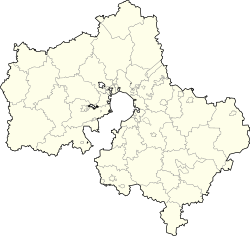world.wikisort.org - Russia
Volokolamsk (Russian: Волокола́мск) is a town and the administrative center of Volokolamsky District in Moscow Oblast, Russia, located on the Gorodenka River, not far from its confluence with the Lama River, 129 kilometers (80 mi) northwest of Moscow. Population: 23,433 (2010 Census);[3] 16,656 (2002 Census);[8] 18,226 (1989 Census).[9]
Volokolamsk
Волоколамск | |
|---|---|
Town[1] | |
 View of Volokolamsk Kremlin | |
 Flag  Coat of arms | |
Location of Volokolamsk  | |
 Volokolamsk Location of Volokolamsk  Volokolamsk Volokolamsk (Moscow Oblast) | |
| Coordinates: 56°02′N 35°57′E | |
| Country | Russia |
| Federal subject | Moscow Oblast[1] |
| Administrative district | Volokolamsky District[1] |
| Town | Volokolamsk[1] |
| First mentioned | 1135[2] |
| Elevation | 170 m (560 ft) |
| Population | |
| • Total | 23,433 |
| • Estimate (2018)[4] | 19,824 (−15.4%) |
Administrative status | |
| • Capital of | Volokolamsky District[1], Town of Volokolamsk[1] |
Municipal status | |
| • Municipal district | Volokolamsky Municipal District[5] |
| • Urban settlement | Volokolamsk Urban Settlement[5] |
| • Capital of | Volokolamsky Municipal District[5], Volokolamsk Urban Settlement[5] |
| Time zone | UTC+3 (MSK |
| Postal code(s)[7] | 143600, 143602–143604, 143608 |
| Dialing code(s) | +7 49636 |
| OKTMO ID | 46605101001 |
History
It was first mentioned in the Voskresensk Chronicle under the year 1135.[2] It was built by Novgorodian merchants on a 5-kilometer (3.1 mi) portage (Russian: Волок/Volok) on a waterway from Novgorod to Moscow and Ryazan, hence the name "Volokolamsk" (i.e., "Volok on the Lama"). In 1178, the town was burned by Vsevolod the Big Nest, who added it to Vladimir-Suzdal lands. His son Yaroslav II restored it to Novgorod in 1231. After the Mongol invasion of Rus', the town was divided into two parts: one assigned to Novgorod and another one to the Grand Dukes of Vladimir. The Principality of Tver failed to take it in 1273.
Ivan Kalita presented his part of the town to the boyar Rodion Nestorovich, who presently wrested the other part from Novgorod. In 1345, Simeon the Proud gave Volokolamsk to his father-in-law, one of Smolensk princes. While in possession of Smolensk, the town withstood a siege by Algirdas during the Lithuanian–Muscovite War (1368–72). Vladimir the Bold defeated Tokhtamysh near Volokolamsk in 1383. Soon thereafter, it reverted to Novgorod. The town remained the southernmost enclave of the Novgorod Republic until 1398, when Vasily I definitively incorporated it into the Grand Duchy of Moscow. Ten years later, it was granted for two years to Švitrigaila, who had just defected to Moscow. Having lost its Hanseatic trade and connections with Novgorod, the town declined and was not mentioned by any sources for the next half a century. It was in 1462, when Volokolamsk was given by Ivan III to his younger brother, that the town became the seat of a full-scale appanage principality. Its first prince erected the single-domed limestone Resurrection Cathedral, which still stands. Another prince was Andrey Volotsky; the chief monument from his reign is the three-domed cathedral of the Vyazmischi Cloister (1535).

In 1613, Volokolamsk braved a siege by Sigismund III Vasa, an event which led to the town's fortifications being represented on its coat of arms. By that time, Volokolamsk had been associated primarily with the Joseph-Volokolamsk Monastery, situated 17 kilometers (11 mi) to the northeast.
The Soviet authority in Volokolamsk was established in late October 1917. During World War II, a number of violent clashes between the German and Soviet troops and partisans took place near Volokolamsk. The town was under German occupation from October 27 to December 20, 1941, when it was liberated by the 331st Rifle Division.
Administrative and municipal status
Within the framework of administrative divisions, Volokolamsk serves as the administrative center of Volokolamsky District.[1] As an administrative division, it is, together with seven rural localities, incorporated within Volokolamsky District as the Town of Volokolamsk.[1] As a municipal division, the Town of Volokolamsk is incorporated within Volokolamsky Municipal District as Volokolamsk Urban Settlement.[5]
International relations
Twin towns – sister cities
Volokolamsk is twinned with:
|
In popular culture
Alexander Bek's 1944 novel, Volokolamsk Highway («Волоколамское шоссе»), is a lightly-fictionalized account of the defensive fighting by elements of the 316th Rifle Division along the road from Volokolamsk to Moscow in October, 1941.
The online game War Thunder (where one controls Armored vehicles such as Tanks) features a ground forces map titled "Volokolamsk", and a larger version titled "Surroundings of Volokolamsk". The map is derided from players as being too open and being too big.[11]
Volokolamsk landfill
In Volokolamsk, there is a controversial landfill. Many protests have occurred over it as the landfill has given many people respiratory problems. The Russian authorities have not yet done anything about the problem.[12]
References
Notes
- Resolution #123-PG
- Энциклопедия Города России. Moscow: Большая Российская Энциклопедия. 2003. p. 89. ISBN 5-7107-7399-9.
- Russian Federal State Statistics Service (2011). Всероссийская перепись населения 2010 года. Том 1 [2010 All-Russian Population Census, vol. 1]. Всероссийская перепись населения 2010 года [2010 All-Russia Population Census] (in Russian). Federal State Statistics Service.
- "26. Численность постоянного населения Российской Федерации по муниципальным образованиям на 1 января 2018 года". Federal State Statistics Service. Retrieved January 23, 2019.
- Law #1/2005-OZ
- "Об исчислении времени". Официальный интернет-портал правовой информации (in Russian). June 3, 2011. Retrieved January 19, 2019.
- Почта России. Информационно-вычислительный центр ОАСУ РПО. (Russian Post). Поиск объектов почтовой связи (Postal Objects Search) (in Russian)
- Russian Federal State Statistics Service (May 21, 2004). Численность населения России, субъектов Российской Федерации в составе федеральных округов, районов, городских поселений, сельских населённых пунктов – районных центров и сельских населённых пунктов с населением 3 тысячи и более человек [Population of Russia, Its Federal Districts, Federal Subjects, Districts, Urban Localities, Rural Localities—Administrative Centers, and Rural Localities with Population of Over 3,000] (XLS). Всероссийская перепись населения 2002 года [All-Russia Population Census of 2002] (in Russian).
- Всесоюзная перепись населения 1989 г. Численность наличного населения союзных и автономных республик, автономных областей и округов, краёв, областей, районов, городских поселений и сёл-райцентров [All Union Population Census of 1989: Present Population of Union and Autonomous Republics, Autonomous Oblasts and Okrugs, Krais, Oblasts, Districts, Urban Settlements, and Villages Serving as District Administrative Centers]. Всесоюзная перепись населения 1989 года [All-Union Population Census of 1989] (in Russian). Институт демографии Национального исследовательского университета: Высшая школа экономики [Institute of Demography at the National Research University: Higher School of Economics]. 1989 – via Demoscope Weekly.
- Volokolamski pravac
- "Volokolamsk - War Thunder Wiki".
- "A 'mini-Chernobyl' in Moscow's suburbs".
Sources
- Губернатор Московской области. Постановление №123-ПГ от 28 сентября 2010 г. «Об учётных данных административно-территориальных и территориальных единиц Московской области», в ред. Постановления №252-ПГ от 26 июня 2015 г. «О внесении изменения в учётные данные административно-территориальных и территориальных единиц Московской области». Опубликован: "Информационный вестник Правительства МО", №10, 30 октября 2010 г. (Governor of Moscow Oblast. Resolution #123-PG of September 28, 2010 On the Inventory Data of the Administrative-Territorial and Territorial Units of Moscow Oblast, as amended by the Resolution #252-PG of June 26, 2015 On Amending the Inventory Data of the Administrative-Territorial and Territorial Units of Moscow Oblast. ).
- Московская областная Дума. Закон №1/2005-ОЗ от 11 января 2005 г. «О статусе и границах Волоколамского муниципального района и вновь образованных в его составе муниципальных образований», в ред. Закона №127/2010-ОЗ от 29 октября 2010 г. «О внесении изменений в Закон Московской области "О статусе и границах Волоколамского муниципального района и вновь образованных в его составе муниципальных образований"». Вступил в силу со дня официального опубликования. Опубликован: "Ежедневные Новости. Подмосковье", №20, 4 февраля 2005 г. (Moscow Oblast Duma. Law #1/2005-OZ of January 11, 2005 On the Status and the Borders of Volokolamsky Municipal District and the Newly Established Municipal Formations Comprising It, as amended by the Law #127/2010-OZ of October 29, 2010 On Amending the Law of Moscow Oblast "On the Status and the Borders of Volokolamsky Municipal District and the Newly Established Municipal Formations Comprising It". Effective as of the day of the official publication.).
External links
- Volokolamsk kremlin (in Russian)
На других языках
- [en] Volokolamsk
[ru] Волоколамск
Волокола́мск — город областного подчинения в Московской области России, административный центр Волоколамского городского округа, историческое поселение, имеющее особое значение для истории и культуры Московской области[2]. Волоколамск является старейшим городом в Московском регионе (первое упоминание относится к 1135 году).Другой контент может иметь иную лицензию. Перед использованием материалов сайта WikiSort.org внимательно изучите правила лицензирования конкретных элементов наполнения сайта.
WikiSort.org - проект по пересортировке и дополнению контента Википедии
